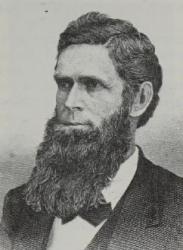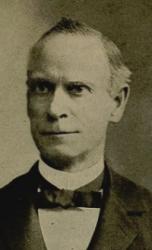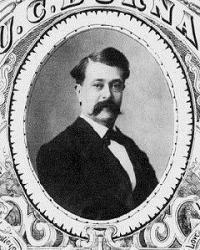Planning worship?
Check out our sister site, ZeteoSearch.org,
for 20+ additional resources related to your search.
- |
User Links
Person Results
Samuel A. Baldwin
1862 - 1949 Person Name: Samuel A. Baldwin, 1862-1949 Composer of "BALDWIN" in AGO Founders Hymnal
Samuel A. Baldwin
L. O. Emerson

1820 - 1915 Composer of "LASSELL" in Praise in Song Luther Orlando Emerson was born at Parsonsfield, Maine, August 3, 1820. He descended from distinguished English ancestry. His parents were quite musical, and while the family circle were together, they had a choir and orchestra of their own. The father played the violoncello, the mother was an excellent singer, the flute and violin added their sweet tones, till the quiet homestead rang with melody.
Mr. Emerson's education was obtained at the district school, Parsonsfield Seminary and Effingham Academy. He was full of energy, quick and versatile, an apt scholar, and with a view to entering the profession of medicine he entered Dracut Academy, Mass. But his great love for music swerved him from that course, and now, having far better opportunities for cultivating and enjoying this taste and ability, he soon determined upon music as the profession of his choice. He accordingly commenced a course of musical instruction under the late I. B. Woodbury, then a popular teacher of music. After several years of study on the voice, piano, organ and in harmony, Mr. Emerson went to Salem, Mass., began teaching, and took charge of his first choir at a salary of one hundred dollars per year. Here he commenced the composition of music for his own choir, whiich was so popular with its members and the congregation, that Mr. Emerson was encouraged to seek a larger hearing by publishing a collection of church music. Among the tunes was that of Sessions, named after his pastor, which was destined to have a perennial popularity, and is often used in worship in the place of Old Hundred, for the Doxology. At the great Peace Jubilee it was received with applause when sung by a chorus of ten thousand voices, accompanied by an orchestra of two hundred instruments and a great pipe organ. The effect was sublime beyond expression.
In 1847 occurred the marriage of Mr. Emerson to Miss Mary Gore, daughter of a prominent Boston merchant. She was a lady of much musical taste and ability.
In 1853 he decided to make an effort to put his music before the public, and accordingly went to Boston in search of a publisher. Like most young and unknown authors, he met with but little encouragement, but finally found a publisher in the person of Mr. B. B. Muzzy. Thus was the Romberg Collection published. The book was not pushed — hence it found no market.
After a residence of eight years in Salem, Mr. Emerson removed to Boston, accepting the position of organist and musical director at the Bulfinch Street Church, then under the pastoral care of Rev. Wm. R. Alger, which he filled for four years. He eagerly improved the rare means of culture which were once more enjoyed, meanwhile teaching and composing music.
In 1857 he formed the connection with Oliver Ditson Company, of Boston, of author and publisher, which has continued to the present time with but one interruption (a single volume brought out by another firm), the Golden Wreath, which at once became popular, and sold forty thousand during the first year, this being the initial volume in the long series since brought out by these publishers. In 1858 came the Golden Harp, which was also a success. These successes gave him not only encouragement, but reputation.
Mr. Emerson now entered upon a career of usefulness and popularity for which he had been preparing during the years of self-denying struggle and discipline. He was called to take charge of the music in the Second Congregational Church, Greenfield, Mass., and also of the musical department of Power's Institute, at Bernardston. Amid nature's most beautiful surroundings, he had a quiet retreat for the pursuit of his true vocation, the composition of church music.
The first fruit of his genius here was the Sabbath Harmony, in 1860. This book was also a success. In 1863 followed the Harp of Judah, which had the remarkable sale of nearly fifty thousand copies in the first three months. This book probably gave Mr. Emerson his preeminence as a composer of church music, containing as it did his anthem, Guide Me, O Thou Great Jehovah, and many of his finest compositions.
Having declined the solicitations of Dr. Lowell Mason to become his associate in music, Mr. Emerson started forth on his own plans, and attained the highest rank among those who loved the pure and beautiful in song. Mr. W. S. B. Mathews, a musical critic, pronounces him the best melodist of all the psalmodic writers.
In 1866 the equally successful Jubilate appeared, followed by the Choral Tribute, the Standard and the Leader. In the last two Dr. I. R. Pahner was associated with him. Later on came the Salutation, Voice of Worship, Herald of Praise, etc. The diligence with which Mr. Emerson plied his pen can be estimated when one recalls the fact that he has made seventy-two collections of music, embracing music for churches, singing schools, public schools, choral societies and conventions, instruction books for voice, organ, etc. He has also composed and published scores of songs, quartets and instrumental pieces.
The great amount of work this represents can only be appreciated by those who have undertaken similar labors. Some years ago the degree of Doctor of Music was conferred upon Professor Emerson by the Faculty of Findlay College, Findlay, Ohio.
For many years past. Dr. Emerson has devoted his energies to the grand purpose of elevating the general character of music in our churches, and thus largely advancing the interests of true worship. He places great stress upon the mission of church music. He regards sacred music as the best expression of devotional feeling that exists. He looks upon sacred song as prayer, and believes that it inspires and intensifies prayer. With this view he has taken an active and prominent part in musical festivals and conventions, of which he has conducted over three hundred throughout the United States and Canada. As a conductor, he stands in the front rank. As a teacher. Dr. Emerson has an exceedingly happy faculty of imparting in a concise manner to his classes. His very pleasing address enables him to command the undivided attention of his pupils.
As a singer, he has always held high rank, and has sung much in public. His voice is a baritone of great compass, and quite powerful. As a lecturer upon music, Dr. Emerson has attracted much attention. His most popular lecture is entitled The World of Music, in which he traces its origin and progress, and gives some excellent traits of the lives of the great composers. In this lecture he also shows the design of music, and how it has been prized in every age of the world, among all nations — its power in the Church and State, and the need of its influence in the family — in joy and sorrow — for this life and the life to come.
-Biography of Gospel Song and Hymn Writers
L. O. Emerson
Anonymous
Person Name: Unknown Composer of "TARRY WITH ME" in The Songs of Zion In some hymnals, the editors noted that a hymn's author is unknown to them, and so this artificial "person" entry is used to reflect that fact. Obviously, the hymns attributed to "Author Unknown" "Unknown" or "Anonymous" could have been written by many people over a span of many centuries.
Anonymous
Knowles Shaw

1834 - 1878 Composer of "TARRY WITH ME" in New Christian Hymn and Tune Book Knowles Shaw (1834-1878), a name familiar in many western households--was born near New London, in Morgan Township, Ohio, on the 13th of October, 1834. His mother's maiden name was Huldah Griffin, and by both of his parents he was of Scottish extraction. His early life was spent in Rush County, Indiana, where he first began to play the violin, furnishing the music for many a dance. While the ball was going on he was converted, ceasing to play in the middle of the piece he was performing. Very soon thereafter he entered the ministry of the Christian Church. On the 11th of January, 1855, he married Miss Martha Finley. Most of his time after entering the ministry was spent in the West and South, and on account of his wonderful vocal powers he was called the "singing evangelist."
As a singer he was considered, in some respects, equal to Sankey and Bliss. reporters of the press al spoke of his singing as something wonderful. Soon after beginning to preach, he began to compose and to write music. His first song was "The Shining Ones," still popular. He published at different times five singing-books: "Shining Pearls," "Golden Gate," "Sparkling Jewels," "The Gospel Trumpet," and the "Morning Star." "Bringing in the Sheaves" was one of the last songs from his hand.
His last meeting was held in Dallas, Texas, in May 1878. He was killed by a railroad accident, going from Dallas to McKinney, on the 7th of June, 1878. During his ministry he baptized over eleven thousand persons.
--A History and Biographical Cyclopedia of Butler County, Ohio. Cincinnati, 1882. DNAH Archives
Knowles Shaw
John Erskine
1879 - 1951 Composer of "ST. PAUL'S" in The Hymnal John Erskine (October 5, 1879 – June 2, 1951) was an American educator and author, pianist and composer. He was first an English professor at Amherst College from 1903 to 1909, followed by Columbia University from 1909 and 1937, during his tenure he formulated General Honors Course, which later founded the influential Great Books movement. He published over 100 books, novel, criticism, essays including his most important essay, The Moral Obligation to Be Intelligent (1915).
Erskine was born in New York City, New York, the son of Eliza Jane (née Hollingsworth) and James Morrison Erskine, and raised in Weehawken, New Jersey. He graduated from Columbia University, B.A., 1900, M.A. 1901 and Ph. D., 1903 and D. Litt. 1929, besides D. Litt. degree from Amherst in 1923.
Professor Erskine first remained English professor at Amherst College from 1903 to 1909, subsequently taught at Columbia University from 1909 to 1937. In 1920, he instituted Columbia College's General Honors Course, a two-year undergraduate seminar that would later help inspire "Masterworks of Western Literature," now known commonly as "Literature Humanities," the second component of Columbia College's Core Curriculum. This course taught the classics in translation instead of the original Latin or Greek, and concept he elaborated in his noted essay The Moral Obligation to Be Intelligent. He found little support for the course from the senior faculty, and junior faculty members like Mark Van Doren and later after 1923, Mortimer Adler took up sections of the course. This course would later go on to inspire the Great Books movement, centered on the Great Books of the Western World. The course was discontinued in 1928, though later reconstituted. In 1929, Adler left Columbia to join University of Chicago, where continued working on the theme with Robert Hutchins, President of the University. Together they subsequently went on to found the Great Books of the Western World program and the Great Books Foundation.
Erskine co-wrote the 1900 Varsity Show at Columbia, writing musical score for libretto The Governor's Vrouw (1900), a two-act comic opera by Henry Sydnor Harrison and poet Melville Cane, who also wrote the lyrics. He won the Butler Medal in 1919. During his career Erskine published over 100 books, [1] though as a writer he first received acclaimed with his novel, The Private Life of Helen of Troy (1925), which was adapted to silent film, by the same the name in 1927, directed by Alexander Korda. Other films based his works were, A Lady Surrenders (1930) by John M. Stahl, Bachelor of Arts (1934) by Louis King and The President's Mystery (1936) directed by Phil Rosen. The 1956, biopic of French noble women, Diane de Poitiers, titled Diane was based on his story with screenplay by Christopher Isherwood. He was also the author of numerous publications, including several humorous novels retelling myths and legends, besides essays, criticism, and two volumes of autobiography. These included Penelope's Man and Adam and Eve, Though He Knew Better.
Erskine was also accomplished composer, pianist and musician, he wrote several books of music and the libretto for George Antheil's opera Helen Retires (1931), which was based on The Private Life of Helen of Troy. He remained the first president of the Juilliard School of Music from 1928 to 1937. He also remained director of the Metropolitan Opera Association, which runs the Metropolitan Opera, a noted opera company based in New York City.
To commemorate the seven hundredth anniversary of Roger Bacon, Erskine wrote A Pageant of the Thirteenth Century, a biographical play which was produced at Columbia University and published as a book by Columbia University Press in 1914. The Archives and Special Collections at Amherst College holds a collection of his papers. In 1946 he served as the first chairman of the American Writers Association.
He was married twice, Helen Worden Erskine (m. 1946–1951), Pauline Ives (m. 1910–1945). With his wife, Pauline (Ives), he was the grandfather of actress Lindsay Crouse and the great-grandfather of actress Zosia Mamet. He died on June 2, 1951 in New York, New York at the age of 71.
--en.wikipedia.org/wiki/
John Erskine
Asa Hull

1828 - 1907 Person Name: A. Hull Composer of "[Tarry with me, O my Savior]" in Loving Voices Asa Hull USA 1828-1907. Born in Keene, NY, he became a music publisher in New York City. He married Emma F Atherton, and they had a daughter, Harriett. He wrote many tunes and authored temperance rallying songs. He published 33 works, of which 21 were songbooks, between 1863-1895. He died in Philadelphia, PA.
John Perry
Asa Hull
U. C. Burnap

1834 - 1900 Composer of "SEPARATION" in Songs of Praise and Prayer Burnap ran a dry goods business in Brooklyn, though he graduated from the University of Paris with a music degree, and for 37 years played the organ at the Reformed Church in Brooklyn Heights. He was a prolific composer, and helped edit the following:
Hymns of the Church, 1869
Hymns of Prayer and Praise, 1871
Hymns and Songs of Praise, 1874
--The Cyber Hymnal™
There is uncertainty about his middle name. Reynolds and the Library of Congress say it was Christopher. A contemporary obituary relied on by "The Cyber Hymnal™" says it was Cicero. It appears that there was another Uzziah C[icero] Burnap who lived (per LOC) 1794-1854.
U. C. Burnap
Caryl Florio
1843 - 1920 Composer of "SMITH" in Gloria Deo Real name William James Robjohn. He used Caryl Florio as a pseudonym.
Caryl Florio
Friedrich von Flotow

1812 - 1883 Person Name: Flotow Composer of "[Tarry with me, O my Saviour]" in Good-Will Songs Friedrich Adolf Ferdinand, Freiherr von Flotow
Friedrich von Flotow


 My Starred Hymns
My Starred Hymns

